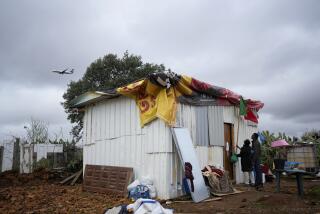Rugs Loom Large as Excellent Buys in Portugal
- Share via
ARRAIOLOS, Portugal — Among the most beautiful collectibles available in Portugal are handmade Arraiolos rugs.
Hand-embroidered in beautiful, earthy and vibrant colors and intricate patterns, the rugs are still created according to centuries-old techniques, making them affordable treasures that will likely increase in value.
Although the rugs are available in specialized shops in the United States and other countries, smart shoppers who buy in Portugal have a great advantage. Prices in the United States are generally five or six times higher. Further, the selection available in Portugal is better, and rugs can be specially ordered for color and pattern.
Credit for initiating Portugal’s rug-weaving tradition probably can be given to the Moors who wove carpets to use as wall coverings and prayer rugs. When the Moors settled in the village of Arraiolos (pronounced Ar-ray-oh-loush), where fertile farming and grazing land was available, they taught their rug-making techniques to local women and the town’s name thereafter became synonymous with embroidered rugs.
Now among Portugal’s leading cottage industries, Arraiolos rugs are still fashioned using the Moors’ exacting techniques. Traditionally, the rugs were made in the home, but recently the work has moved to small factories.
To make the rugs, a sturdy jute backing is covered with an elongated cross-stitch reinforced by a double thickness of wool yarn.
Because manufacture of Arraiolos rugs doesn’t require a loom, they can be made in any size, shape, pattern and color.
Two grades of stitching are used: fine point and gros point. Fine point allows for greater intricacy of design but requires more time to make and is, therefore, more expensive. It also is more durable.
Rugs made during the 17th and 18th centuries were often rectangular and used four basic design elements. Plants, including two dozen varieties of flowers, were popular, as were geometric patterns based on intricate linear Moorish designs. Animals and birds, hearts, crowns and amphoras were also used.
During the 19th Century, the Napoleonic Wars, the exile of Portuguese nobility to Brazil and economic difficulties undermined Portuguese rug-making. But the industry was revived in the early 1900s by Portuguese artist Jose de Quieros, who researched ancient patterns and found bright, clear dyes. Rug-making spread from Arraiolos to other towns in Portugal, especially to the north near the city of Oporto.
Arraiolos rugs attracted international attention between 1920 and 1940 when Europeans and Americans began collecting them. New design elements, based on French Aubusson and English floral patterns, were introduced.
Today, some rugs are made with modified palette and patterns to suit the tastes of contemporary buyers, but many traditional design elements, especially floral and geometric patterns, have been retained.
Several people may work on one rug simultaneously. It takes a fast worker about 15 days to complete about 40 square inches of fine point, which has more than 40,000 stitches. Such work makes the prices sound like bargains.
Ready-made rugs cost from $12 to $28 per square foot. Special orders cost 35% to 45% more. U.S. import duties will add 9.8% to the purchase price.
After purchase, the rugs are easy to transport home. A 9-by-12-foot rug can be folded into a suitcase-size bundle. Or the rugs can be shipped.
In Lisbon, an excellent source of Arraiolos rugs is Casa Quintao, a century-old, family-run business. The shop (at Rua Ivens 30) regularly exports rugs to the United States.
On the first floor, you’ll find antique furniture and objets d’art. The rug treasury is on the second floor, up a palatial stairway that is often cluttered with burlap-bagged rugs ready for shipment. The walls of the spacious gallery are covered with exquisite and varied Arraiolos, many with grand dimensions. On the floor are stacks of variously sized and shaped rugs. You can spend several pleasant hours lifting rug corners to peek at items buried in the stacks.
If you’re not sure of colors, you may request sample yarns to bring home for comparison with other furnishings. Before you buy, check for quality: Place the rug on the floor to make sure it lies flat and inspect the underside to see that the pattern is as clearly defined there as it is on the top.
Casa Quintao also sells a limited selection of Arraiolos rug kits that include all supplies and instructions. A 2-by-4-foot rug kit sells for about $65, a 4-by-6-foot for $150.
Another good Lisbon rug shop is Arraiolos Trevo (Avenida Oscar Montiero-Torres 33-A), which has a fine selection.
Or you might prefer to visit Arraiolos for the day. The town is about 90 miles southeast of Lisbon. If you go, you’ll still see women busily stitching rugs along the town’s charming cobblestone streets.
In Arraiolos, Tapetes de Arraiolos Condestaval has a fine collection of rugs and will fill special orders. The shop also has a branch in nearby Evora. Both shops are open 9 a.m. to 1 p.m. and 2 to 7 p.m. In Arraiolos, workshop hours are 8 a.m. to noon and 1 to 6 p.m., Monday through Friday.
Prices quoted in this article reflect currency exchange rates at the time of writing.
More to Read
Sign up for Essential California
The most important California stories and recommendations in your inbox every morning.
You may occasionally receive promotional content from the Los Angeles Times.













